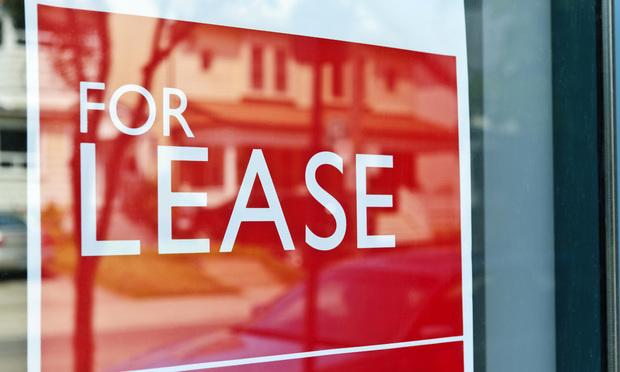Tracking the Evolution of the Retail Lease
The retail landscape is changing, and being changed, by numerous forces, so landlords of such properties should consider changing their approach to the retail lease.
April 17, 2019 at 02:00 PM
8 minute read
 Photo by Elenathewise
Photo by Elenathewise
To borrow from Mark Twain's famous quote, the reports of the death of retail (and the retail lease) have been greatly exaggerated. In fact, although reports of the demise of the brick-and-mortar retail establishment have abated, it was not long ago that many were claiming that traditional U.S. retail was dead—never to return.
But with the benefit of time, it would seem that a more accurate prognosis is that retail is now in the midst of a dramatic evolution. Rather than dying, the retail landscape is changing, and being changed, by numerous forces. And so, landlords of such properties, as they plan to meet these changes by reconfiguring and repositioning their properties, should also consider changing their approach concerning the retail lease.
The retail lease is the retail landlords' primary document governing their properties. In addition, it spans a multi-year term and therefore—unlike a purchase and sale agreement—is an agreement that creates an ongoing relationship between two parties. Therefore, especially in certain cases (such as a 50-year retail ground lease, for example), it must establish the parameters of a long-term relationship of the parties, while allowing for inevitable and also unforeseeable changes that occur over time.
In order to evaluate the evolving retail lease in this context, where rapidly changing forces are necessitating a reexamination of the relationship document called the “retail lease,” let us start by noting certain provisions that have become scarce among these agreements. For example, the ongoing co-tenancy clause, once a ubiquitous tenant tool, especially for larger retail tenants (often big-box shopping center tenants), is now rarely seen in retail leases. This should not be surprising. After all, how could a retail landlord agree to such a concept—that a tenant be allowed a significant rent reduction or a lease termination right if another co-tenant in the center decides to go dark—when retail, as mentioned, is undergoing such profound changes? Landlords simply cannot risk such a bet, that its tenant mix will remain static in a retail environment that is anything but static, no matter what the particular tenant's leverage is.
Another formerly common retail lease concept is percentage rent. Simply, how could a retail landlord agree to percentage rent when, for many retail tenants in the digital era, selling products from its stores is becoming less of the focus? And that is a point worth emphasizing. Perhaps the most significant development that the retail lease needs to navigate, from both the landlord and tenant perspective, is that it is becoming less of an agreement concerning the sale of products. In fact, the whole meaning of “retail” is changing, which of course means that the meaning of the “retail lease” is necessarily changing too.
Although retail tenants have certainly not abandoned the notion of selling goods in their brick-and-mortar stores, for many of them, such premises are becoming an experiential place. Although many retailers can sell their products in cyberspace, a brick-and-mortar store is still needed, where the customer can see, touch and handle the product, experience the retailer's offerings and brand, and perhaps be amazed and entertained through a sensory experience. This is where the physical retail premises are heading, and the way in which “stores” will remain vibrant and necessary.
As this new purpose of the retail store emerges, is there any wonder why co-tenancy requirements and percentage rent provisions are becoming obsolete?
Conversely, as some traditional retail locations are morphing into non-retail, but experiential, spaces, mirror-opposite changes are occurring as well, completing the evolutionary circle. Specifically, office and even industrial properties are now wading into the retail waters, adding to this dynamic.
To illustrate, I recently negotiated three leases, two of which were, primarily, for office space, and the other was for a large industrial/warehouse facility. However, all three tenants required a retail use to be allowed in their premises. The industrial tenant, an alcohol-beverage distributor, required a significant portion of its 200,000 plus square foot premises to be used as a tasting room. Perhaps that is not a pure retail use like a tavern—the tasting room was to be used for salespeople—but this tenant's need necessitated, from a lease negotiation perspective, traditional retail provisions concerning approvals, a liquor-license contingency, special parking needs, operating hours, and even signage. Certain liability issues and insurance requirements, that were not previously an issue for this industrial landlord, now were essential points to be raised. When this lease was completed and signed, it was hard to tell where the industrial lease provisions ended and the retail ones began.
The other two examples were office leases, but like the industrial-lease example, the tenants had to use a portion of their space as a showroom for merchandise. This “experiential” need was critical for both tenants (much like the tasting room), and it was a condition to each deal. For one of the leases, zoning issues had to be addressed, and for the other, because it was a sublease, the retail restrictions and prohibited uses in the prime lease had to be completely revamped.
Thus, in a world where the retail lease is becoming less about selling goods to the public, and office and industrial leases must incorporate retail-like uses, how does the traditional landlord's lease survive? The answer is that it doesn't. It must evolve with these changes. Outdated retail concepts, which either fix a tenant mix or disproportionately rely on the sale of goods from a premises, need to be revised, if not discarded. While certain other retail ideas, not previously worth mentioning for other types of leases, now need to be considered and negotiated.
The above are mainly examples of lease changes that we have seen. But what about the changes that are only just emerging within the retail world, and what about unforeseeable changes? How does the retail lease adapt to that?
Consider Amazon, not for the changes it forced onto the retail universe by way of its internet-based platform, but for its recent foray into the brick-and-mortar world with its acquisition of Whole Foods. In this case too, traditional retail is being transformed, and so will the retail lease. For example, as has been reported, Whole Foods is now looking to offer multiple product lines, beyond that which is typically offered in grocery stores. If and when this becomes a reality, this will undoubtedly have an impact on another retail-lease favorite—the tenant's exclusive use provision. Specifically, how could a landlord agree to an evolving exclusive for the benefit a supermarket tenant in an environment where the neighborhood grocer sells books, bicycles, maybe even financial services and products? The new retail lease will certainly have to address that.
Sticking with the “supermarket of the future” example, much has also been reported about drones acting as a new delivery system. Soon, it is possible that rather than the traditional model of customers coming to the grocery store, the store's goods will be transported directly to the customer. This upheaval will also dramatically change retail and, therefore, the retail lease. We can only begin to speculate how the lease of the future will have to address these fleets of drones, but surely it will have a big impact on the way parking rights are allocated in the lease (not to mention how parking lots are designed in the field), as well as other issues mentioned above, such as hours of operation and, never to be minimized, liability issues.
Like it or not, retail in the U.S. is undergoing great changes, with no sign of going back. Some changes we have already seen, like the evolution of the experiential retail space, while others, like drone-based delivery systems, are only now emerging from what could have been characterized as a sci-fi novel not too long ago. Accordingly, retail leases are evolving too (along with office and industrial leases), as they should. Traditional lease concepts, no longer applicable in many cases, are being discarded, while new provisions, sometimes from other types of leases, are now encroaching to and from the retail lease. It is a fluid and exciting time for retail, which is surely not dead. Landlords that appreciate these changes, and seek to update their retail leases, will surely benefit in the fast-approaching future.
Philip Markowitz is a member of Saiber LLC, in Florham Park. He is part of the firm's real estate practice group.
This content has been archived. It is available through our partners, LexisNexis® and Bloomberg Law.
To view this content, please continue to their sites.
Not a Lexis Subscriber?
Subscribe Now
Not a Bloomberg Law Subscriber?
Subscribe Now
NOT FOR REPRINT
© 2025 ALM Global, LLC, All Rights Reserved. Request academic re-use from www.copyright.com. All other uses, submit a request to [email protected]. For more information visit Asset & Logo Licensing.
You Might Like
View All


'A More Nuanced Issue': NJ Supreme Court Considers Appellate Rules for Personal Injury Judgments
5 minute readTrending Stories
- 1'A Death Sentence for TikTok'?: Litigators and Experts Weigh Impact of Potential Ban on Creators and Data Privacy
- 2Bribery Case Against Former Lt. Gov. Brian Benjamin Is Dropped
- 3‘Extremely Disturbing’: AI Firms Face Class Action by ‘Taskers’ Exposed to Traumatic Content
- 4State Appeals Court Revives BraunHagey Lawsuit Alleging $4.2M Unlawful Wire to China
- 5Invoking Trump, AG Bonta Reminds Lawyers of Duties to Noncitizens in Plea Dealing
Who Got The Work
J. Brugh Lower of Gibbons has entered an appearance for industrial equipment supplier Devco Corporation in a pending trademark infringement lawsuit. The suit, accusing the defendant of selling knock-off Graco products, was filed Dec. 18 in New Jersey District Court by Rivkin Radler on behalf of Graco Inc. and Graco Minnesota. The case, assigned to U.S. District Judge Zahid N. Quraishi, is 3:24-cv-11294, Graco Inc. et al v. Devco Corporation.
Who Got The Work
Rebecca Maller-Stein and Kent A. Yalowitz of Arnold & Porter Kaye Scholer have entered their appearances for Hanaco Venture Capital and its executives, Lior Prosor and David Frankel, in a pending securities lawsuit. The action, filed on Dec. 24 in New York Southern District Court by Zell, Aron & Co. on behalf of Goldeneye Advisors, accuses the defendants of negligently and fraudulently managing the plaintiff's $1 million investment. The case, assigned to U.S. District Judge Vernon S. Broderick, is 1:24-cv-09918, Goldeneye Advisors, LLC v. Hanaco Venture Capital, Ltd. et al.
Who Got The Work
Attorneys from A&O Shearman has stepped in as defense counsel for Toronto-Dominion Bank and other defendants in a pending securities class action. The suit, filed Dec. 11 in New York Southern District Court by Bleichmar Fonti & Auld, accuses the defendants of concealing the bank's 'pervasive' deficiencies in regards to its compliance with the Bank Secrecy Act and the quality of its anti-money laundering controls. The case, assigned to U.S. District Judge Arun Subramanian, is 1:24-cv-09445, Gonzalez v. The Toronto-Dominion Bank et al.
Who Got The Work
Crown Castle International, a Pennsylvania company providing shared communications infrastructure, has turned to Luke D. Wolf of Gordon Rees Scully Mansukhani to fend off a pending breach-of-contract lawsuit. The court action, filed Nov. 25 in Michigan Eastern District Court by Hooper Hathaway PC on behalf of The Town Residences LLC, accuses Crown Castle of failing to transfer approximately $30,000 in utility payments from T-Mobile in breach of a roof-top lease and assignment agreement. The case, assigned to U.S. District Judge Susan K. Declercq, is 2:24-cv-13131, The Town Residences LLC v. T-Mobile US, Inc. et al.
Who Got The Work
Wilfred P. Coronato and Daniel M. Schwartz of McCarter & English have stepped in as defense counsel to Electrolux Home Products Inc. in a pending product liability lawsuit. The court action, filed Nov. 26 in New York Eastern District Court by Poulos Lopiccolo PC and Nagel Rice LLP on behalf of David Stern, alleges that the defendant's refrigerators’ drawers and shelving repeatedly break and fall apart within months after purchase. The case, assigned to U.S. District Judge Joan M. Azrack, is 2:24-cv-08204, Stern v. Electrolux Home Products, Inc.
Featured Firms
Law Offices of Gary Martin Hays & Associates, P.C.
(470) 294-1674
Law Offices of Mark E. Salomone
(857) 444-6468
Smith & Hassler
(713) 739-1250







